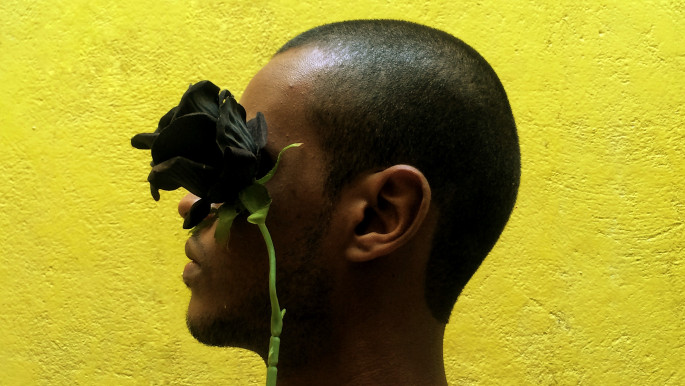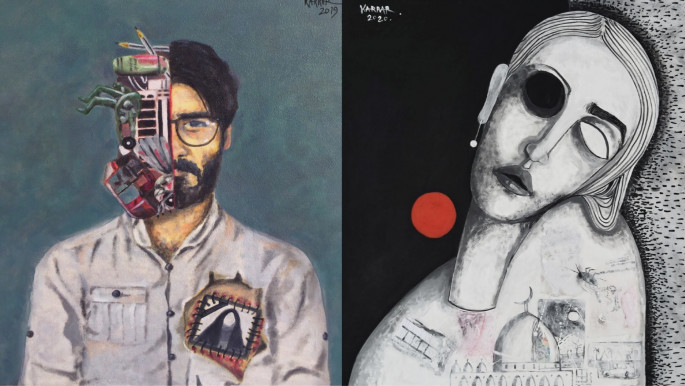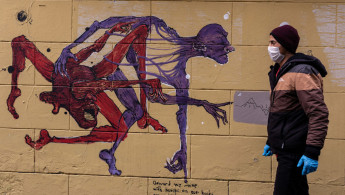Why art in the Middle East matters more than ever
Long before Covid-19, conflict, unrest, and occupation had already presented formidable challenges to artists in many if not all Arab nations, from Iraq to Yemen via Palestine and Lebanon.
Now, the pandemic has made problems like access to public spaces, museums, galleries, and concert venues that much worse, with many finding themselves stranded without their main source of livelihood.
"To be in Yemen, it means to continue doing what you love despite the difficulties. Even with the war, bad economy, no electricity, and bad internet connection, we still create art," says Asim Ahmed, a photographer from Aden, Yemen.
"The resilience with which we live here is reflected in how we produce art".
In his city the coronavirus death toll has spiked in the recent weeks, leading many to assume the spread of the virus had been underreported. But threats to human life have always been rife in Aden, a hotspot of violence during the civil war, which means he is well used to working in difficult conditions.
Asim says he has to stop working often, especially when the conflict escalates sometimes for weeks on end, with no certainty of when he can resume his craft.
 |
Even with the war, bad economy, no electricity, and bad internet connection, we still create art -Asim Ahmed |
 |
"We have no art schools, there are no galleries, there is no art scene in Yemen, and yet we learn everything ourselves and don't depend on our government. We are determined to become artists anyway."
Most of Yemen's population already depended on aid for their basic survival, and artists, who often struggle to make ends meet even in prosperous countries, are in a vulnerable position.
 |
|
| Flower faced, 2020. [Instagram/@asim_aziiz] |
Asim says that many families worry for their sons and daughters who want to venture into the art world, with little money for artists in Yemen, a country surviving by the skin of its teeth.
In a recent photography project, Asim photographed a seemingly normal intimate domestic scene of women at home but with the backdrop of a nearly collapsed building destroyed in the war.
He named the series 'Homesick' and said it reflected Yemeni resilience during wartime.
"We are still here, and we are still trying to live our life normally since this is our home and we have nowhere to go," he told The New Arab.
Nasser Al Mang, a Yemeni-American activist based in San Francisco, is founder of Yemen Will Triumph, which helps young people gain access to media, culture technology and arts.
He told The New Arab that his efforts to push for more art spaces in Yemen will suffer greatly in the current climate.
"Even before the war, the government and NGOs didn't show enough interest in supporting the arts in Yemen. When the war broke out even the little amount of art initiatives were stopped," he said.
"In the last two years there has been a re-emergence of interest in them, but now I'm afraid Covid-19 will make things even worse."
 |
Allowing self-expression is a democratic right, so the ability to produce art is inherently a cornerstone of democracy -Ibtisam Barakat |
 |
The YWT has trained 70 filmmakers, produced 15 films, and started organising their first ever film festival focused on human rights which was supposed to take place in October of this year before the pandemic broke out. Nasser says that because of the war, and now the pandemic, he is struggling to secure the funding needed for YWT.
This funding could also be the difference between life and death for many young people in Yemen.
| Instagram Post |
"International donors are discouraged from investing in the arts in Yemen because everything is going towards humanitarian efforts, which I understand, but I also believe that art can spark social change. If we don't support the youth, there is a chance they will be recruited to go to the frontline of the war," says Nasser.
Nasser's ominous warning underscores just how much art in the Middle East has always been deeply political.
During the 2011 Arab Spring wave of uprisings, which reignited in 2019, art of all forms and mediums overtook the streets of Tunis, Cairo, Sanaa, and Damascus, painting a whole generation's demands on the walls for the world to see.
Before the outbreak of the Covid-19 pandemic, young artists in Iraq and Lebanon took to the streets again to spray paint the slogans of their fellow protesters.
Poignant graffiti, meanwhile, covers Israel's separation wall in Palestine and the walls of refugee camps in Lebanon, Jordan, and Syria.
In Egypt, the recent death of 24-year-old filmmaker Shady Habash sparked outrage and despair, underscoring the challenge that art can pose to authoritarianism.
He had been detained without charge since March 2018 for directing a music video criticising the country's autocratic President Abdel Fattah al-Sisi.
"Art is self-expression. Injustice is to halt the self-expression of pain, wounds, and your voice. Allowing self-expression is a democratic right, so the ability to produce art is inherently a cornerstone of democracy," said Ibtisam Barakat, a Palestinian-American author who grew up in Ramallah in the West Bank during the aftermath of Israel's occupation in 1967.
Her memoir Tasting the Sky: A Palestinian Childhood won critical acclaim for covering the realities of Palestinians growing up during that time, such as being separated from her family and the struggles of becoming a refugee.
"The interesting thing about Covid-19 is how similar it is with the circumstances of the Palestinian people," she says. "Except that Palestinians have to go through this oppression on their own and the entire world is not trying to find a cure for it."
 |
Art has always played a pivotal role in the region's activism and political discourse |  |
The perception of the Middle East within a global political context often fails to mention the region's rich culture. Instead, images of war, poverty, and death flood the front pages and newsreels of international media outlets, which breeds dangerous biases of the region.
 |
|
| Read more: Surrealist painter captures Iraq's descent into the abyss of corruption and decay |
"Systems of image production about the Middle East have long been dictated by Western conceptions of the region," Antony Downey, Professor of Visual Culture in North Africa and the Middle East at Birmingham City University told The New Arab.
"Western media and the military industry have been complicit in portraying the Middle East in a certain light in order to maintain its command in the region. Artists have repeatedly addressed precisely this issue of imaginative command, and they have deconstructed the regimes of image making," says Downey.
With the recurring upheaval in the region, many artists like Asim in Yemen echo this idea, seeking to reflect not only hardships but also the everyday joys of life.
"I need the world to know that Yemen isn't only about the war, poverty, and pain," the young Yemeni photographer said.
"We also have a beautiful side of Yemen, the art, the simplicity of life, the love we have for each other".
Gaia Caramazza is a journalist at The New Arab.
Follow her on Twitter @GaiaCaramazza



